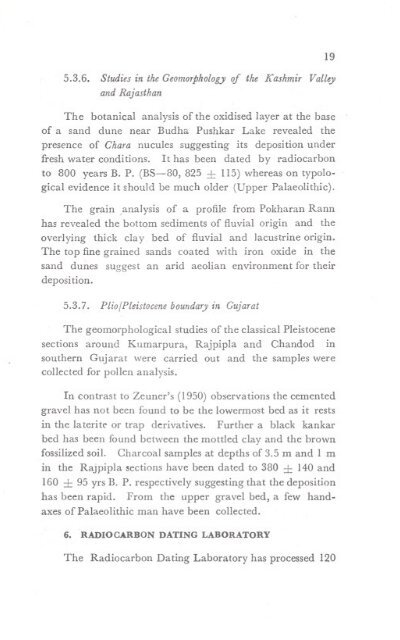AR 1978-79.pdf - Birbal Sahni Institute of Palaeobotany
AR 1978-79.pdf - Birbal Sahni Institute of Palaeobotany
AR 1978-79.pdf - Birbal Sahni Institute of Palaeobotany
Create successful ePaper yourself
Turn your PDF publications into a flip-book with our unique Google optimized e-Paper software.
5.3.6. Studies in the Geomorphology if the Kashmir Valley<br />
and Rajasthan<br />
The botanical analysis <strong>of</strong> the oxidised layer at the base<br />
<strong>of</strong> a sand dune near Budha Pushkar Lake revealed the<br />
presence <strong>of</strong> Chara nucules suggesting its deposition under<br />
fresh water conditions. It has been dated by radiocarbon<br />
to 800 years B. P. (B5-80, 825 ± 115) whereas on typological<br />
evidence it should be much older (Upper Palaeolithic).<br />
The grain ,analysis <strong>of</strong> a pr<strong>of</strong>ile from Pokharan Rano<br />
has revealed the bottom sediments <strong>of</strong> fluvial origin and the<br />
overlying thick clay bed <strong>of</strong> fluvial and lacustrine origin.<br />
The top fine grained sands coated wi th iron oxide in the<br />
sand dunes suggest an arid aeolian environment for their<br />
deposition.<br />
5.3.7. Plio/Pleistocene boundary in GuJarat<br />
The geomorphological studies <strong>of</strong> the classical Pleistocene<br />
sections around Kumarpura, Rajpipla and Chandod 10<br />
southern Gujarat were carried out and the samples were<br />
collected for pollen analysis.<br />
In contrast to Zeuner's (1950) observations the cemented<br />
gravel has not been found to be the lowermost bed as it rests<br />
in the laterite or trap derivatives. Further a black kankar<br />
bed has been found between the mottled clay and the brown<br />
fossilized soil. Charcoal samples at depths <strong>of</strong> 3.5 m and 1 m<br />
in the Rajpipla ,ections have been dated to 380 ± 140 and<br />
160 ± 95 yrs B. P. respectively suggesting that the deposition<br />
has been rapid. From the upper gravel bed, a few handaxes<br />
<strong>of</strong> Palaeolithic man have been collected.<br />
6. RADIOC<strong>AR</strong>BON DATING LABORATORY<br />
19<br />
The Radiocarbon Dating Laboratory has processed 120

















